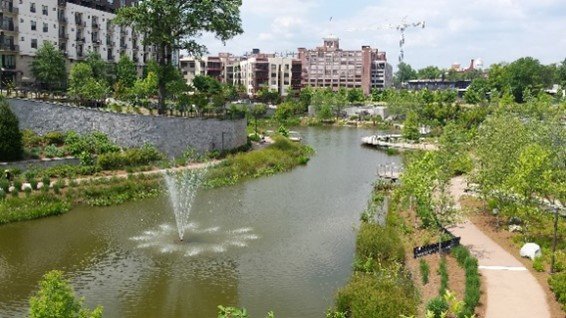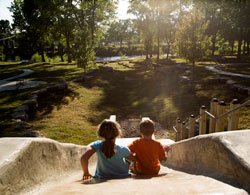Smart Growth and Water
Background

Development affects the natural flow of stormwater in a watershed. When rain hits impervious surfaces such as roofs, streets, and parking lots, it runs off in large quantities, carrying pollutants it picks up from those surfaces. The increased quantity and speed of this stormwater can erode stream channels and destabilize their banks, while pollutants harm plants and wildlife in rivers, streams, and bays. Increased runoff can also cause water treatment plants to overflow, releasing untreated sewage into water bodies.
By developing compactly, preserving ecologically critical open space and using green infrastructure strategies, communities and the developers that work in them can reduce quantity of runoff, protect water quality and conserve water. More compact development, with less impervious surface, generates less stormwater runoff per unit of development. It can also conserve drinking water because when shorter pipes are needed to serve a community, it reduces the amount of water lost to leaks. Developing in existing communities, rather than establishing new ones, can help reduce the pressure on open space with valuable ecological functions, such as buffering a water body.

Green infrastructure techniques, such as rain gardens, permeable soils or pavements and green roofs, mimic natural processes that capture stormwater, slow it down, absorb some of it into the ground and filter out pollutants before releasing the remaining runoff to storm sewers or waterways. Rain barrels and cisterns can conserve drinking water by storing runoff for nonpotable uses such as irrigation. These green infrastructure practices can also make streets and buildings more attractive and reduce ambient air temperatures.
As communities cope with climate change impacts, many regions will see heavier rainfalls, more drought, and increased flooding. Smart growth strategies can help communities develop in safer areas, integrate green infrastructure to reduce stormwater runoff, and use water more efficiently.
Technical Assistance
EPA offers technical assistance to help communities plan for and develop resilient water infrastructure and services.
- Water TA is a free EPA program that helps communities access federal funding for water infrastructure and water service.
- Equitable Resilience Technical Assistance was an EPA program that provided design assistance and project development support to disaster-prone and disadvantaged communities. The program webpage provides successful examples of communities using nature-based solutions to protect water resources.
- Greening America's Communities/Greening America's Capitals was an EPA technical assistance program that provided design assistance to help communities envision and plan for green infrastructure to help revitalize neighborhoods. The program webpage highlights the successful efforts of communities to use green infrastructure to manage water resources.
Topical Resources
EPA has published research, tools and guidance on the intersection of development and water, including how to: manage stormwater, mitigate pollution and enhance water quality, conserve water resources and adapt to climate change impacts.
Stormwater Management and Green Infrastructure
- Disaster Resilient Design Concepts (2023): Offers design concepts and case studies to help communities reduce the impact of disasters, recover more quickly, strengthen local economies, and create safer, more equitable places to live by reducing hazards. Includes concepts for communities facing greater risks from hurricane and coastal flooding, inland and riverine flooding, and more.
- Soak Up the Rain: Links to EPA tools that communities and individuals can use to help prevent water pollution, reduce flooding, protect water resources, beautify landscapes, and bring many benefits to communities.
- City Green: Innovative Green Infrastructure Solutions for Downtowns and Infill Locations (2016): Case studies of projects around the country that illustrate how green infrastructure techniques can be used on sites that have limited space and other constraints to bring environmental and community benefits.
- Enhancing Sustainable Communities With Green Infrastructure (2014): Guide to help communities integrate green infrastructure and sustainable communities strategies to plan and design green infrastructure for multiple environmental, health, economic, and social benefits.
- Managing Vacant and Abandoned Property in the Green Zone of Saginaw, Michigan (2014): Report from a technical assistance project with the city of Saginaw, Michigan, to develop a land use and infrastructure strategy that stabilizes neighborhoods through the sustainable reuse of abandoned properties, supports redevelopment of abandoned properties as green infrastructure, and creates opportunities for long-term economic growth.
Water Quality and Conservation
- Land Use and Green Infrastructure Scorecard (2023): Guides municipalities through a review of local plans, policies, and municipal practices to illuminate opportunities to better protect water resources while maximizing the additional community benefits available through green infrastructure, including flood mitigation, public health, and climate resilience.
- Sustainable Design and Green Building Toolkit for Local Governments (2013): Addresses the local codes of ordinances that affect the design, construction, renovation, and operation and maintenance of a building and its immediate site (including elements that affect water use) to help local governments, the development community, and other building professionals identify and remove barriers to sustainable design and green building in their permitting processes.
- Growing Toward More Efficient Water Use: Linking Development, Infrastructure, and Drinking Water Policies (2006): Focuses on the nexus between water and accommodating community growth. It also explores water policies that can support sustainable development.
- Protecting Water Resources with Smart Growth (2004): Intended for audiences already familiar with smart growth concepts who seek specific ideas on how techniques for smarter growth can protect water resources. Offers 75 policies that communities can use to grow in the way that they want while protecting their water quality.
Waterfront Development

- Urban Waters Federal Partnership: EPA partnership program that reconnects urban communities with their waterways.
- Flood Resilience Checklist (2014): Tool designed to help a community determine whether it is prepared for a flood.
- Planning for Flood Recovery and Long-Term Resilience in Vermont: Smart Growth Approaches for Disaster-Resilient Communities (2014): Report from a technical assistance project with the Federal Emergency Management Agency (FEMA), the state of Vermont, and the Mad River Valley Planning District on how communities in Vermont can recover from flood impacts from Tropical Storm Irene and become more resilient to future disasters.
- Smart Growth for Coastal and Waterfront Communities (2009): Guide developed by EPA, NOAA, Rhode Island Sea Grant, and the International City/County Management Association that builds on existing smart growth principles to offer 10 development guidelines for coastal and waterfront communities, along with tools, techniques, and examples.
